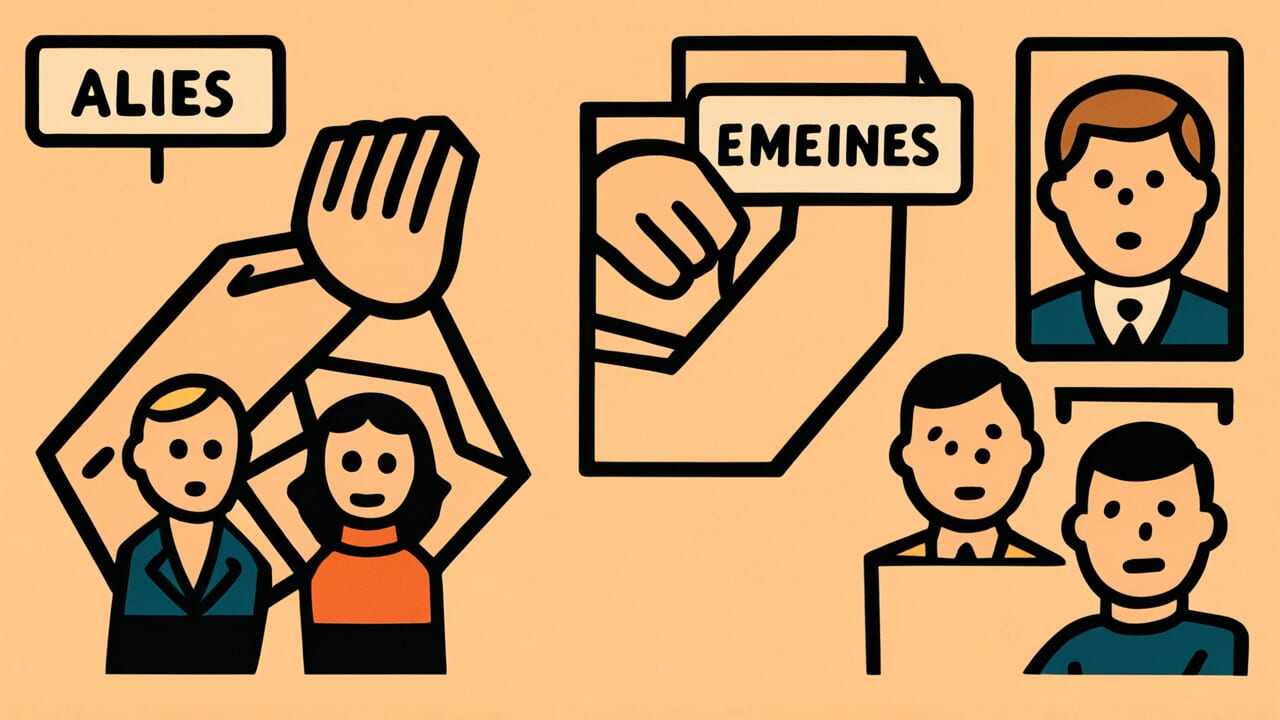How to Read “Among enemies there are allies, among allies there are enemies”
Teki ni mikata ari, mikata ni teki ari
Meaning of “Among enemies there are allies, among allies there are enemies”
This proverb expresses a complex truth about human relationships. Some people you consider enemies can become your allies. Some people you trust as allies can become your enemies.
It teaches us not to judge people based only on their surface position or relationship to us.
Even among those who oppose you, you might find someone who understands or helps you. On the other hand, someone you believed was on your side might act against you.
This can happen because of conflicting interests or misunderstandings.
People use this proverb in politics, business negotiations, organizational dynamics, and everyday relationships. Even today, you might find supporters among competing companies.
Or you might discover that someone you thought was your ally is actually holding you back.
This proverb teaches us not to view relationships as fixed. We should always remember that human connections can change.
Origin and Etymology
The exact origin of this proverb is uncertain, with several theories existing. Based on its structure and content, it likely shows influence from Chinese classical thought and military strategy texts.
The expression uses opposing concepts of “enemy” and “ally” while showing that the boundary between them is not fixed.
This approach is common in warring states period wisdom and military strategy.
Throughout Japan’s history of warfare, people deeply understood the complexity of human relationships. Those thought to be allies would betray.
Those considered enemies would unexpectedly help. Such experiences repeated themselves in both samurai and merchant worlds.
This proverb represents the crystallization of human observation cultivated through that history.
The structure of the phrase itself is interesting. The first and second halves form a parallel couplet.
“Among enemies there are allies” and “among allies there are enemies” are two contrasting truths placed side by side.
This concisely expresses the unpredictability and complexity of human relationships. The brevity and symmetry make it memorable, which is one reason it has been passed down through generations.
Usage Examples
- That project was full of unexpected developments—truly “among enemies there are allies, among allies there are enemies”
- As they say, “among enemies there are allies, among allies there are enemies,” so you never really know who your true supporters are until the end
Universal Wisdom
This proverb has been passed down because it brilliantly captures the essential uncertainty of human relationships. We seek comfort by dividing the world into “allies” and “enemies.”
But real people don’t fit into such simple categories.
People change their positions depending on circumstances. They change their actions based on interests. This isn’t only caused by betrayal or dishonesty.
Everyone has their own situation, sees things differently, and values different things.
Yesterday’s enemy becomes today’s friend. Yesterday’s friend becomes today’s enemy. This proves that humans are complex and multifaceted beings.
This proverb doesn’t teach cynical distrust. Rather, it offers wisdom for understanding the fluidity of relationships and responding flexibly.
Don’t reject everything just because someone is an enemy. Don’t trust blindly just because someone is an ally.
Such calm perspective gives us strength to navigate complex human society.
Our ancestors witnessed this truth repeatedly through power struggles and survival competition. They realized something important.
Human relationships are not fixed. They constantly change like living creatures. This insight remains a profound wisdom about human nature that never fades, no matter how times change.
When AI Hears This
There’s a famous experiment called the Prisoner’s Dilemma. Two people both benefit if they cooperate. But you gain even more if you betray the other person.
In a single round, betrayal is the correct answer.
But when this game repeats many times, surprising results emerge. Computer simulations tested various strategies against each other.
The most successful was “tit for tat.” This simple rule cooperates first, then betrays if the opponent betrays, and cooperates again if the opponent returns to cooperation.
In other words, neither enemy nor ally is fixed—the relationship switches instantly based on the other’s actions.
What’s more interesting is why this strategy succeeds. Mathematical calculations show something unexpected.
A group with a certain proportion of betrayers is actually more stable than one where everyone cooperates unconditionally.
In other words, having occasional betrayers among allies and cooperators among enemies creates the evolutionarily strongest state.
This discovery is shocking. The distinction between enemy and ally is just a fixed label humans created.
The actual optimal strategy is to continuously update relationships based on each person’s behavioral history. Mathematics proves this.
A fluid state where both betrayal and cooperation constantly coexist is actually the most rational world.
Lessons for Today
This proverb teaches modern people the importance of flexible perspective in relationships. In the social media age, we’ve grown accustomed to simple divisions.
“Followers” versus “everyone else.” “Likes” versus “no response.” But real human relationships are much more delicate and complex.
At work or school, don’t judge people based only on surface relationships. Among those who oppose you, someone might understand your thinking.
Conversely, friends you’re always with might actually be heading in different directions. This isn’t sad—it’s the natural state of humanity.
What matters is accepting this reality while acting with integrity. Don’t take extreme attitudes like ignoring enemies or blindly trusting allies.
Instead, engage carefully with each individual person.
If you do this, you’ll encounter moments when unexpected supporters appear or misunderstandings clear up. The uncertainty of human relationships is actually a door to new possibilities.



Comments